NHS hospitals and buildings' £261m backlog of urgent repairs
- Published
- comments
Half of the NHS estate in Wales is more than 35 years old
Wales' dilapidated NHS buildings need £261m worth of work on problems deemed to pose high or significant risks.
The seven health boards and two NHS trusts have a combined maintenance backlog of £560m, according to the latest available figures.
The cost of the most urgent repairs rose by nearly two-thirds in a year.
Most health boards said they could not afford assessments to see the true extent of maintenance issues, despite needing to do so every five years.
Boards across the country are struggling to maintain outdated facilities and that is having an effect on patient care.
The total maintenance backlog of £561m in 2017-18 across NHS Wales equated to almost 9% of its total day-to-day spending.
BBC Wales analysis found:
Half of the NHS estate in Wales is more than 35 years old and 13% is more than 70 years old - predating the establishment of the NHS
13% of the estate does not comply with statutory and safety compliance - including fire - in Betsi Cadwladr and Powys health boards non-compliance is 22%
Betsi Cadwaldr, the biggest health board, also has the biggest maintenance backlog in the most serious high risk category - £28.6m
Cardiff and Vale has more than £100m of repairs that, if not completed, are judged to be of high or significant risks - the highest figure in Wales
The Welsh Ambulance Service has the most serious problems regarding the condition of its 113 buildings - with only 36% of its estate being judged of a reasonable standard both in terms of physical condition and functional suitability

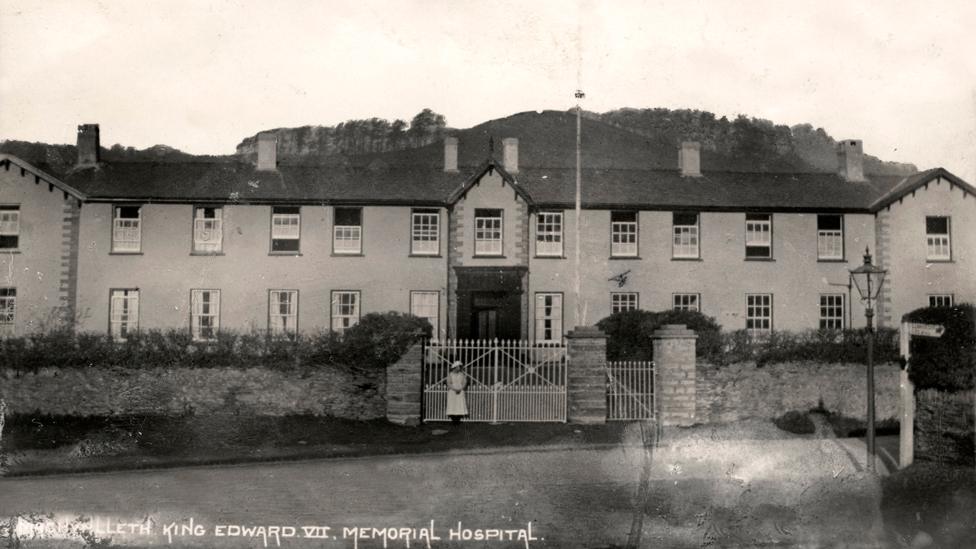
The Edward VII Memorial Hospital at Machynlleth opened in 1923 in a former workhouse - The main building is still part of Bro Ddyfi Hospital
Hospital's changing face since Victorian times
Powys has more old hospital buildings than anywhere else in Wales and shows the challenges of a changing NHS, which inherited an estate dating back to Victorian times, while other buildings from the 1970s and 1980s are showing their age.
The main block at Bro Ddyfi hospital in Machynlleth dates from 1860, when it was a workhouse. In 1923, it became the King Edward VII memorial hospital and later the town's chest hospital.
Extensions to the building were built as the health service developed but in recent years water has been getting in and some of the first floor was deemed unsafe. It was estimated it would cost £4.2m to deal with the maintenance backlog and refurbishing this front block alone.
The old extensions and a portable building are now being replaced with a new wing costing £3.7m.
It will include new facilities including a health hub with community services, adult mental health centre, palliative care suite and space for a "therapy garden".

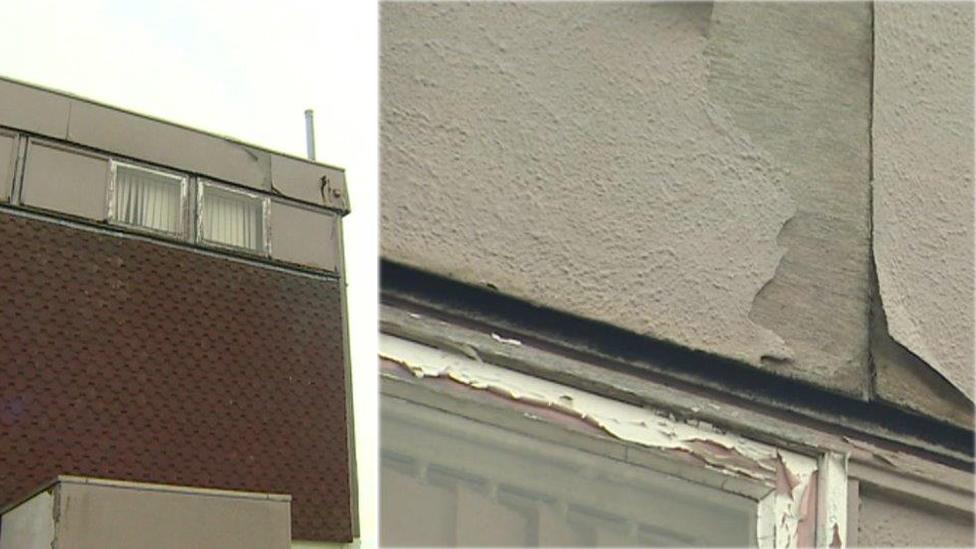
This pathology laboratory at Wrexham was only supposed to be a short-term fix - but has been used for 43 years
'We have to work with what we've got'
At Wrexham Maelor, electric cabling, heating and water leaks are the most immediate issues - and when work is done, it has to be carried out so it does not impact on patient care.
Significant parts of the endoscopy unit, including theatres, had to be closed. Two theatres have since been refurbished.
Jenny Phillips, a sister in the endoscopy unit, said: "We have to work with what we've got at the moment.
"We've kept two rooms running, have put weekends in as best we can and have really been fighting to get on top of waiting times."
The hospital's pathology laboratory is in a building dating from 1976.
The health board is looking for £54m for essential work at the hospital over the next few years - but is also drawing up more long-term plans for modernisation as demands and technology change.
This could mean fewer, but more hi-tech, hospital facilities alongside more in-community care.
"As a health board we're talking about care closer to home and as technology's moving on, the requirement for such a large estate is becoming smaller, so part of the solution I think in future is reducing the estate to essential key working and services," said Rod Taylor, director of estates for Betsi Cadwaladr.
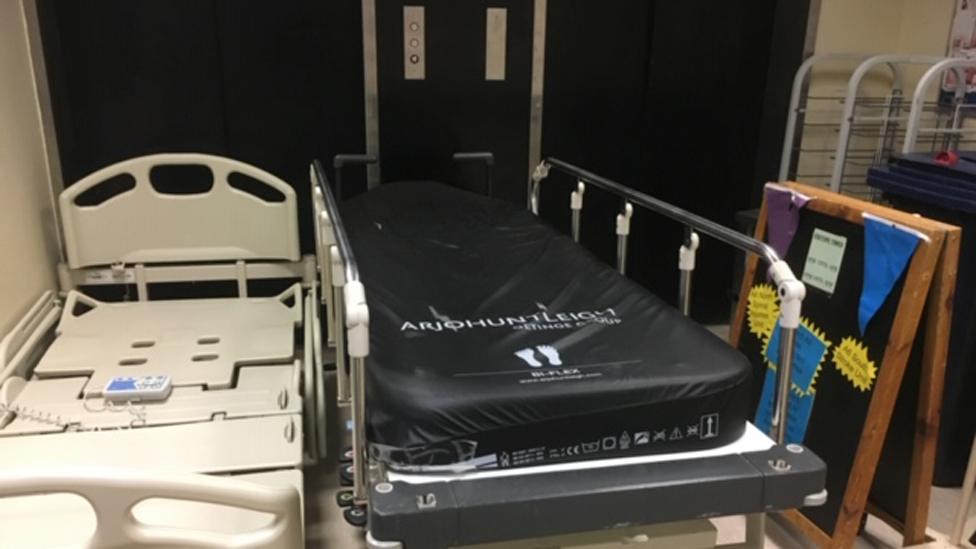
This bed and trolley were left on a landing in one hospital
'It's people cutting corners'
A worker came forward to us with concerns about problems at University Hospital of Wales in Cardiff - when things break down or corners are cut - and claimed there were risks of cross-contamination and infection, including hospital waste being transported in the same lifts as patients.
"You've got the one bin which is used for general waste but will contain food," he said.
"It's not supposed to but it does because it's people cutting corners. That spills all over the floor. You then get people going to visit their gran on 'A' level, walking through that, and taking it into the ward.
"On the other hand you might have infectious clinical waste in another bin that's rested up on the same barrier that you might put your hand on to support yourself in the lift. So everything is [at] massive [risk] of cross-contamination."
"The lower ground of all is called the tunnel - it's basically like a rat warren - but it's used for people in the service industry to get through the hospital, quickly.
"A&E is connected to the 'A' ward lifts when they come out and the lifts are out of order... people resort to going cross-country - they're using the tunnels.
"They're pushing babies, people ill in beds, to the next block to try and get a lift. I've actually seen a family coming in with somebody very ill in a bed being rushed from A&E through the tunnel - through the [spilled] liquids and into the lift to another ward."
Geoff Walsh, director of capital, estates and facilities, acknowledged the challenges Cardiff and Vale health board faced and said many buildings included a complex engineering infrastructure.
"The UHW site has some 81 lifts in total, many of which are some 48 years old," he said.
"The health board is implementing a lift replacement programme which will address many of the problems, although this will take several years to complete.
"We currently have two lifts being replaced and on average we may have up to five lifts out of action on a daily basis as a result of minor faults."
A comprehensive refurbishment programme of wards and engineering is under way and Mr Walsh said all maintenance requests were logged and prioritised in line with clinical need or risk.
Early feasibility studies were also considering options for the replacement of the hospital.
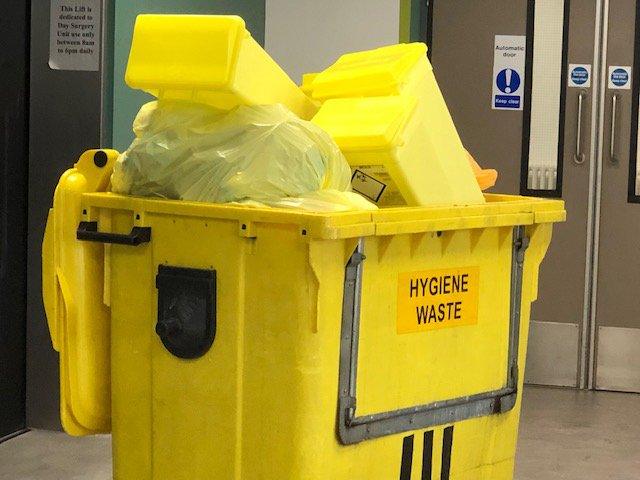
A bin left open in a corridor near a day surgery lift
What about elsewhere?
Other parts of the UK face similar problems.
Analysis by the Health Foundation think-tank showed the maintenance backlog for hospitals in England has risen significantly in recent years, external - £6bn in 2017-18 - with £3bn needed to eliminate the backlog falling into the high or significant risk categories - representing the entire annual capital spend of NHS trusts in England.
Senior economist Ben Gerschlick said the problems in Wales were quite similar and it was important to invest to keep pace and before the problems got worse.
"If you don't get on top of these issues, people going into their local hospital will start to notice that it's not in the condition it should be and in the long run you start to see a real impact on patient safety," he added.
The Welsh Government said it had committed more than £370m in health capital projects this year and £338m next year.
"Health boards and trusts are responsible for ensuring they maintain their estate so people receive safe and sustainable services," said a spokeswoman.
"We are also providing funding for major projects to help us transform the NHS, including the new University Grange hospital in Cwmbran, the major refurbishment of the Prince Charles Hospital in Merthyr Tydfil and more than £70m for the 19 primary and community care projects across Wales."
- Published19 September 2019
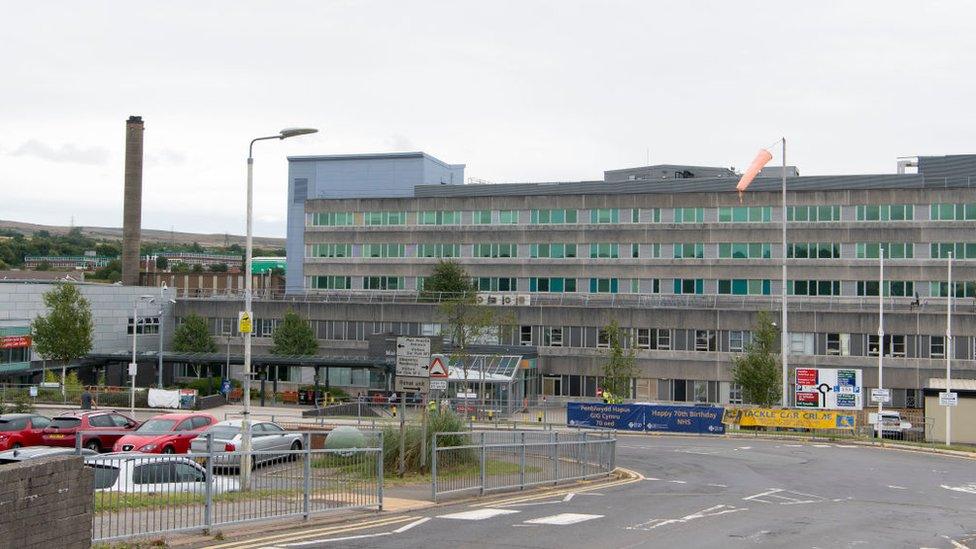
- Published5 August 2019
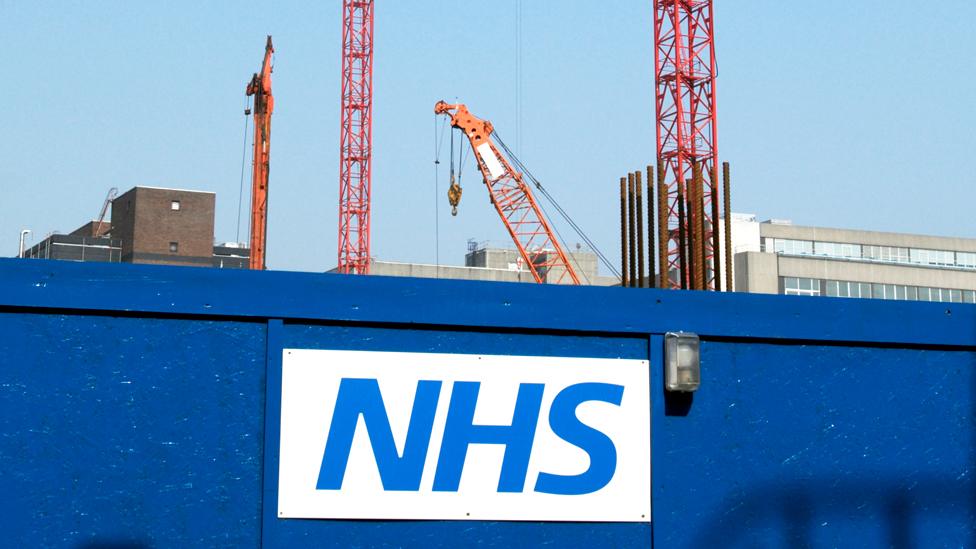
- Published5 August 2019
- Published8 November 2018
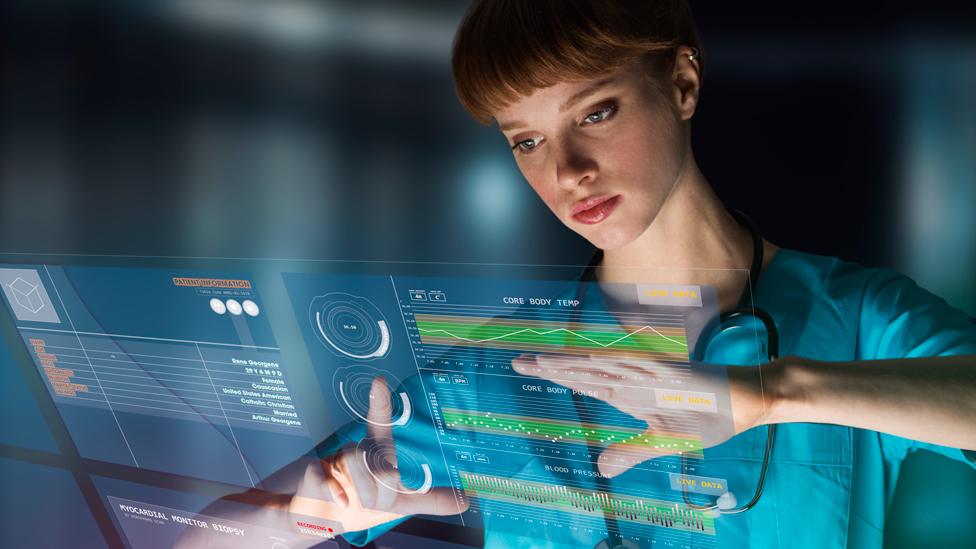
- Published5 July 2018

- Published17 July 2017
